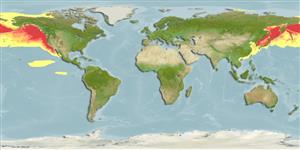Common names from other countries
Environment: milieu / climate zone / depth range / distribution range
экология
батидемерсальный. Subtropical; 90°N - 0°S, 180°W - 180°E
Pacific Ocean and the Arctic.
Length at first maturity / Size / Вес / Возраст
Maturity: Lm ? range ? - ? cm Max length : 210 cm TL самец/пол неопределен; (Ref. 1394); 150 cm TL (female); наибольший вес (опубликованные данные): 270.0 kg (Ref. 1394); наибольший вес (опубликованные данные): 270.0 kg
Feeds on many varieties of epipelagic and vertically migrating schooling and non-schooling fish and squid; feeding is at night (Ref. 1394). Feeds on many varieties of epipelagic and vertically migrating schooling and non-schooling fish and squid; feeding is at night (Ref. 1394).
Life cycle and mating behavior
половая зрелость | размножение | нерест | икра | Fecundity | личинки
Estrus and copulation occur about a week after parturition. Implantation is expected 120 days after copulation.
Основная ссылка
ссылки | координатор | соавторы
Jefferson, T.A., S. Leatherwood and M.A. Webber. 1993. (Ref. 1394)
Статус Красного Списка МСОП (Ref. 130435)
Статус СИТЕС (Ref. 108899)
Not Evaluated
Not Evaluated
Использование человеком
рыболовство: коммерческий
FAO - рыболовство: landings, Видовой профиль | FishSource | Sea Around Us
инструменты
дополнительная информация
ресурсы в Интернет
Estimates based on models
Preferred temperature
(Ref.
115969): 0.2 - 3.8, mean 1.6 (based on 2446 cells).
устойчивость к внешним воздействиям
средний (среднего размера), минимальное время удвоения популяции 1.4-4.4 года (K=0.03-0.38).
Уязвимость
Moderate to high vulnerability (51 of 100).
Категория цены
Unknown.
